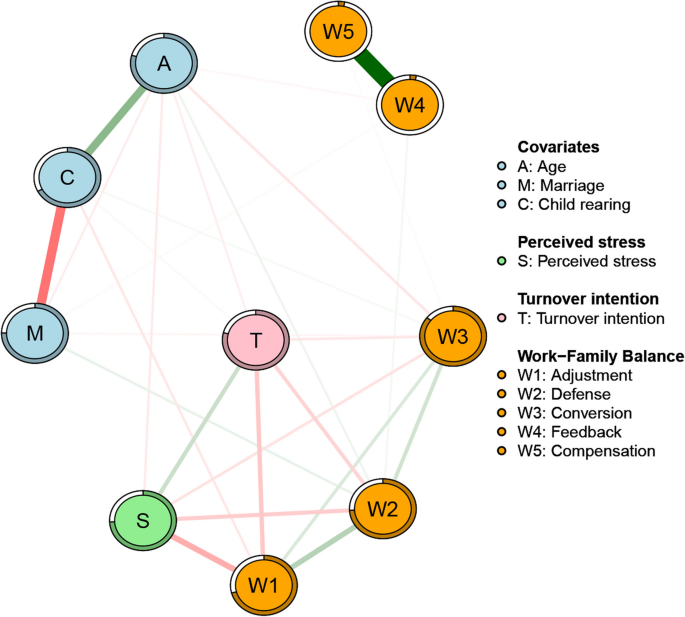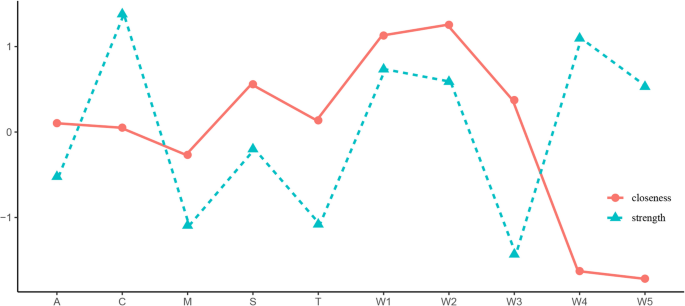Archives of Public Health volume 83, Article number: 149 (2025) Cite this article
Female healthcare workers often experience heightened stress and increased turnover intentions due to work-family imbalance, which significantly disrupts the normal functioning of the healthcare system. The work-family balance is a multidimensional construct, and the complex relationships among its various dimensions, stress levels, and turnover intentions remain unclear.
The study was conducted among 436 female healthcare workers in China from May 2022 to January 2023, using the work-family balance scale, perceived stress scale and turnover intention scale. A network analysis and path analysis of the data were conducted through R software and the PROCESS macro in SPSS.
The feedback, adjustment and defense nodes were the important nodes of the work-family balance, perceived stress and turnover intention network. Adjustment, defense and conversion between the two roles are more strongly associated with perceived stress and turnover intention. Moreover, adjustment, defense and conversion play parallel chain mediation roles between perceived stress and turnover intention.
The family and work of female medical staff can be mutually conflicting (adjustment and defense) and reinforcing (feedback). Moreover, once the mutual conflict and intrusion between family and work intensify, female healthcare workers' stress and turnover intention may increase, even if their work can provide resources for their families. This further suggests that hospital management systems could help female healthcare workers adjust their energy allocation between work and family areas by setting precise work hours, reducing work intrusion at home, and lowering stress and turnover intentions.
Text box 1. Contributions to the literature |
|---|
• The family and work of female medical staff can be mutually conflicting (adjustment and defense) and reinforcing (feedback). |
• The mutual intrusion or conflict between work and family is more strongly associated with perceived stress and turnover intentions among female healthcare workers than the resources and feedback that work and family provide to each other. |
• Once the mutual conflict and intrusion between family and work intensify, female healthcare workers' stress and turnover intention may increase, even if their work can provide resources for their families. |
With the aging population and increasing demand for health services, healthcare systems are under increasing pressure and the demand for healthcare workers has increased significantly [1]. However, studies have shown that approximately 3.2% ~ 53.7% of physicians have turnover intentions, and the turnover rate of female healthcare staff is about 20% to 45% [2, 3]. Moreover, the high turnover rate of predominantly female medical workers has been reported to become a key issue affecting the development of the healthcare system [4]. Therefore, exploring the factors influencing female medical worker turnover intentions and thus targeting the turnover problem has received increasing attention worldwide [3].
Stress is one of the important reasons for the high turnover tendency of female healthcare workers [5]. The study showed that 22% of female medical staff turnover is due to stress [6]. Meanwhile, Bergman et al. [7] found that although male and female healthcare workers spend the same time working overall, female healthcare workers spend more time on family activities (e.g., spending time with children) than men. This indicates that female medical professionals not only have similar job stressors as men, but also take on more family activities and affairs. This phenomenon is particularly prevalent in China. Traditional Chinese culture often expects women to handle household chores, bear children, and take primary responsibility for childcare and homemaking. A previous study found that family duties, like elder care and child-rearing, negatively affect female healthcare workers’ performance and stress levels more than their male peers [8]. Growing research has also revealed that elevated stress levels from work-family imbalance contribute to increased turnover intentions among female healthcare professionals in China [9, 10].
Work-family balance is defined as individuals negotiating and sharing with their role partners in work and family domains to accomplish role behaviors and achieve role goals [11]. Moreover, work-family balance includes five-dimensional structure of adjustment (consciously adjusting conflicts between work and family to maintain balance and stability), defense (the area defends against the intrusion from another area), conversion (interaction level of subjects (events, people, emotions, etc.) in the work and family areas), feedback (the realization of needs or functions in one area assists employees in realizing needs or functions in another area, thus contributing to the increase of inputs in that area) and compensation (receiving certain resources from one area to compensate for some deficiencies in another area, thus reducing conflict and dissatisfaction due to deficiencies in the area) [12].
The role theory provides a crucial theoretical foundation for understanding and explaining work-family balance [13]. The expanded-enhancement theory, a key extension of role theory, suggests that an individual’s multiple roles can not only conflict but also mutually enhance each other [14]. The balance between work and family can reduce individual role conflicts, and the resources accumulated by individuals in the family can regulate work stress, relieve anxiety and depression, and improve well-being [11]. In contrast, an imbalance between work and family will lead to role conflicts, a depletion of individual resources, and an increase in the dual pressure of work and family, thereby inducing negative emotions or even turnover [15]. The most important two roles of female healthcare staff in work-family balance are their role as medical personnel and the role of a family member, and the state of the work-family relationship is the result of these two roles'different behaviors [11]. For example, the positive resources (e.g., emotional connection and social support) gained by female medical staff when participating in family role activities can effectively increase self-efficacy and work engagement, improve work performance as well as the family atmosphere, and ultimately achieve work-family balance and reduce turnover intentions [15].
Although studies have suggested a strong link between work-family balance, stress and turnover intention of individuals, there are still several problems. First, most previous studies tend to consider the work-family balance as a whole, while the work-family balance includes adjustment, defense, conversion, feedback and compensation [12]. For the Chinese, work and family are two areas that are inextricably connected for the employees, and it is believed that work is for the better care of the family. Therefore, the family can cope with a certain degree of conflict and intrusion of work. Even individuals are willing to sacrifice time and energy invested in the family for work to receive more feedback and compensation [12]. This may suggest that even if work-family conflict is shown, internal work-family balance, low stress and turnover intention can be demonstrated as long as the intrusiveness and the corresponding feedback are acceptable. The study found that women are more sensitive to loss than to gain and compensation [16, 17]. This suggests that the defense and adjustment dimensions of work-family balance are more strongly linked to stress and turnover intention in female healthcare professionals. Based on role theory and existing research showing that elevated stress levels from work-family imbalance contribute to increased turnover intentions among female healthcare professionals [9, 10].In line with those, this study proposes that different dimensions of work-family balance have distinct associations with stress and turnover. Moreover, defense and adjustment may influence turnover by affecting stress levels.
Network analysis, an emerging research methodology, has gained prominence in psychology, sociology, and behavioral sciences [18]. It conceptualizes variables as nodes within a network, with their relationships represented as connecting edges. Grounded in complex systems theory and employing graph-theoretical methods, it visualizes the interactions among variables [19], uncovering the structural characteristics of inter-variable associations and the significance of different nodes [20], This approach was applied to explore the network dynamics among stress, work-family balance, and their influence on turnover intentions in female healthcare professionals. Path analysis was integrated to further elucidate how key variables shape turnover intentions. This study may offer valuable insights into the interconnections and dependencies among factors influencing turnover and identify intervention points to reduce turnover among female healthcare professionals in China.
This cross-sectional study recruited participants in China using convenience sampling from May 2022 to January 2023. According to the previous study [21], the network with 7 nodes, and 21 parameters (7 × (7–1)/2) needs to be estimated. According to at least 3–5 individuals per parameter, the sample size in this study is sufficient for conducting network analysis (N = 436). All subjects volunteered to participate in the study and completed the questionnaire anonymously by clicking on the questionnaire link (Questionnaire Star) with their digital device after signing the informed consent form. 495 questionnaires were collected, and 436 valid questionnaires (87.88%) were obtained by deleting questionnaires with participants selecting only one answer for all questions and the same IP address.
Of the 436 female health workers included in the study 301 (69%) were married, 123 (28.2%) were unmarried, and 12 (2.8%) were divorced; 276 (63.3%) had children and 159 (36.5%) had no children. Meanwhile, 283 had a bachelor's degree and below (64.90%), 79 had a master's degree (18.10%), and 74 had a PhDFootnote 1 degree (17.00%). In terms of posts, 73 female medical workers are doctors (16.70%), 315 are nurses (72.20%) and 48 are medical technicians. The average age of the participants was 33.59 years old, and the average length of work was 10.49 years.
Perceived Stress Scale (PSS)
A 10-item scale was developed by Cohen et al. [22]. Five levels of scoring are used, with higher scores indicating greater perceived stress levels. In this study, the Chinese version of the scale had an α-coefficient of 0.879.
Work-Family Balance Scale (WFBS)
Developed by Xueying Lin et al. [12], the 17-item scale is scored on a 5-point scale, with higher scores indicating better work-family balance. The WFBS is a five-dimensional structure that includes adjustment, defense, conversion, feedback and compensation. In this study, the Chinese version of the scale had an α-coefficient of 0.811. Specifically, adjustment (4 items) means consciously adjusting conflicts between work and family to maintain balance and stability; defense (4 items) means that the area defends against the intrusion from another area so that the conflict felt by the area is minimal; conversion (4 items) indicates the degree to which the subjects (events, people, emotions, etc.) of the work and family domains among employees interact with each other; feedback (3 items) means that the realization of needs or functions in one area assists employees in realizing needs or functions in another area, thus contributing to the increase of inputs in that area; compensation (4 items) means that receiving certain resources from one area to compensate for some deficiencies in another area, thus reducing conflict and dissatisfaction due to deficiencies in the area.
Turnover Intention Scale (TIS)
Revised by Scott et al. [23] with 4 items. 5-point scale, with higher scores representing higher turnover intention. In this study, the Chinese version of the scale had an α-coefficient of 0.838.
Demographic variables
Research has indicated that individual characteristics may affect the work-family balance and turnover intention of female medical staff [24]. Therefore, demographic information such as age, marriage, education, child-rearing and position were collected in this study.
Path analysis was conducted using the PROCESS macro (Model 6) in SPSS with a significance level set at α = 0.05. The network analysis was performed using R, below are the details.
Network estimation
The network model of 7 indicators was estimated using the EBIC glasso function in the q graph package of network tools R package [21]. In the network, 7 indicators were depicted as nodes, while the correlations between symptoms were described as edges. The mgm package was used to assess the predictability of each node. A node with a high value of predictability indicated that it is explained by its neighboring nodes [25]. Additionally, edges can be positive (green lines) or negative (red lines) and stronger connections were represented by thicker and more saturated edges. The modularity analyses were performed using the Walktrap algorithm for detecting communities in Glasso networks and implemented in the R package EGA and the igraph.
Centrality estimation
Three indices of centrality were calculated to assess the importance of each node in the network via the centrality Plot function in the graph package [26]. (1) The overall importance of a node in the network is indicated by the strength centrality [27]; (2) The closeness centrality indicated that the impact of one node rapidly spreads to other nodes [28]; (3) The betweenness centrality indicated a bridge node connecting with other node and potential target node for interventions [29]. This study mainly explored the relationship between work-family balance, perceived stress and the turnover intention of female medical staff, and thus chose strength and closeness centrality as the main indicators for analysis.
Network accuracy and stability estimation
The accuracy and stability of the network were calculated using bootstrapping methods in the ‘bootnet’ package [21]. First, the 95% confidence intervals (CIs) of edge-weights accuracy were computed via bootstrapping procedures. The stability of the centrality indices was then assessed using a case-dropping bootstrap, which was summarized using CS-coefficients (correlation stability). The CS-coefficient should be ideally above 0.5 but at least above 0.25 [30].
Common method variance was assessed using Harman’s single-factor test. The unrotated factor analysis identified seven distinct factors, with the first factor accounting for 29.251% of the variance, well below the critical threshold of 50% [31], indicating no significant common method bias in this study.
Correlation analysis revealed that all dimensions of work-family balance among female medical workers were negatively correlated with perceived stress and turnover intention to various degrees (Fig. 1). Meanwhile, age, marital status, and child-rearing were strongly negatively correlated with work-family balance, perceived stress, and turnover intention among female medical professionals, so it was included as covariates in the network analysis.
Correlation graph of work-family balance, perceived stress, and turnover intentions among female medical workers in China (2022–2023). Positive correlations are shown in blue and negative correlations are shown in red. The color intensity and the size of the circles are proportional to the correlation coefficient. The legend colors on the right side of the correlation plot show the correlation coefficients and the corresponding colors. p-values > 0.05 are considered irrelevant and the correlation coefficient values are blank. A, age; M, marriage; C, child rearing; T, turnover intentions; S, perceived stress; W1, adjustment; W2, defense; W3, conversion; W4, feedback; W5, compensation
The network structure of work-family balance, perceived stress, and turnover intentions in female medical workers was depicted in Fig. 2. The ring-shaped pie charts of the network were used to indicate the predictability of nodes, i.e., the mean predictability was 0.641 (range from 0.265 to 0.999, Appendix S1). Network analysis showed that node T (“turnover intentions”) had a strong positive connection with the node S (“perceived stress”) with controlling for the age, marital status, and child-rearing three covariates. Meanwhile, both nodes T (“turnover intentions”) and S (“perceived stress”) were strongly negatively associated with W1 (“adjustment”), W2 (“defense”) and W3 (“conversion”). Moreover, the modularity analyses also showed that three communities of work-family balance, perceived stress, and turnover intentions networks among female medical workers (Fig. 3). Specifically, clusters of nodes T (“turnover intentions”), S (“perceived stress”), W1 (“adjustment”), W2 (“defense”) and W3 (“conversion”), while nodes W4 (“feedback”) and W5 (“compensation”) clusters and the three covariates of age, marital status and child-bearing clustered. The Q values of the network were greater than 0.3 (Q = 0.48), indicating that the clustering found in the network was not random.
Network of work-family balance, perceived stress, and turnover intentions among female medical workers in China (2022–2023). Nodes represent work-family balance, perceived stress, and turnover intentions (an identical layout of nodes was imposed), and edges represent partial correlations between nodes. Edge thickness and darkness indicate the association strength (minimum and maximum edge values were set to be equal across networks), and edge color indicates the correlation valence (green = positive; red = negative)
Modularity network diagram of work-family balance, perceived stress, and turnover intentions among female medical workers in China (2022–2023). Nodes represent work-family balance, perceived stress, and turnover intentions, and edges represent partial correlations between nodes. Edge thickness and darkness indicate the association strength (minimum and maximum edge values were set to be equal across networks), and edge color indicates the correlation valence (green = positive; red = negative)
This study employed pathway analysis to further elucidate the relationships among variables within the turnover intention cluster and their impact on turnover intention among female healthcare workers. After controlling for age, marriage, and child-rearing, all measurement variables were mean-centered. Predictor variable S (“perceived stress”), outcome variable T (“turnover intentions”), and mediators W1(“adjustment”), W2 (“defense”), and W3(“conversion”) were included in the model. A bootstrapping procedure with 10,000 resamples was used to test the mediation effects. The regression analysis results are summarized in Appendix Table S6. Variable S (“perceived stress”) positively predicted T (β = 0.302, t = 4.323, 95% CI = [0.164, 0.440]), while it negatively predicted W1(“adjustment”), W2 (“defense”), and W3(“conversion”) (β = − 0.789, t = − 15.167, 95% CI = [− 0.891, − 0.686]; β = − 0.444, t = − 6.058, 95% CI = [− 0.589, − 0.300]; β = − 0.185, t = − 2.937, 95% CI = [− 0.310, − 0.061]). Furthermore, W1(“adjustment”), W2 (“defense”), and W3(“conversion”) each negatively predicted T (“turnover intentions”) (β = − 0.258, t = − 4.711, 95% CI = [− 0.365, − 0.150]; β = − 0.161, t = − 3.610, 95% CI = [− 0.248, − 0.073]; β = − 0.109, t = − 2.071, 95% CI = [− 0.213, − 0.056]).
The mediation analysis results (Appendix Table S7) revealed that W1(“adjustment”), W2 (“defense”), and W3(“conversion”) significantly mediated the relationship between S (“perceived stress”) and T (“turnover intentions”). Moreover, these mediators demonstrated a parallel chain mediation effect, with a total indirect effect of 0.387. The mediation mechanism comprises seven distinct paths: Path 1: S → W1 → T; Path 2: S → W2 → T; Path 3: S → W3 → T; Path 4: S → W1 → W2 → T; Path 5: S → W1 → W3 → T; Path 6: S → W2 → W3 → T; Path 7: S → W1 → W2 → W3 → T. The detailed mediation model is illustrated in Fig. 3B.
Furthermore, the strength and closeness centrality analysis indicated the W1 (“adjustment”) and W2 (“defense”) nodes were not only the primary point for the work-family balance of female healthcare workers, but also the important nodes in the overall network of work-family, perceived stress and turnover intention (Fig. 4). Specifically, with controlling for covariates (age, marital status and child-rearing), node W4(“feedback”), W1 (“adjustment”) and W2 (“defense”) nodes with the highest strength centrality in the network. Meanwhile, these nodes were also statistically stronger than most other nodes of the network (Appendix S2). Moreover, node W2 (“defense”) had the highest closeness in the network, followed by nodes W1(“adjustment”), S (“perceived stress”) and T (“turnover intentions”).
Node closeness and strength centrality in the network of work-family balance, perceived Stress, and turnover intention among Chinese female healthcare workers (2022–2023). Centrality plot depicting the closeness and strength centrality of each node in the network (z-score). Higher scores represent that the node has greater influence in the network. A, age; M, marriage; C, child rearing; T, turnover intentions; S, perceived stress; W1, adjustment; W2, defense; W3, conversion; W4, feedback; W5, compensation
The edge stability estimation showed moderate stability of the estimated networks: although there were considerable overlaps among the 95% CIs of edge weights, nonoverlapped CIs also existed (Appendix S3) and estimation of edge weight difference indicated edges of higher stability were significantly different with other edges in the network (Appendix S4). Meanwhile, stability estimates of the centrality index showed that the strength and closeness centrality stability coefficient (CS-coefficients) was 0.438 and 0.750, respectively (Appendix S5).
The present study used network analysis to construct the network of work-family balance, perceived stress and turnover intentions in female healthcare workers, controlling for the age, marital status, and child-rearing three covariates.
Firstly, from the overall network, it is observed that three clusters exist in the network of perceived stress, work-family balance and turnover intention of female medical staff. Specifically, three of the five WFB dimensions (adjustment, defense and conversion) with perceived stress and turnover intention as a community. Specifically, adjustment involves consciously managing conflicts between work and family to maintain balance; defense protects against intrusions from other areas to minimize conflict; and conversion refers to the interaction between work and family domains. This suggests that mutual intrusion or conflict between work and family is more strongly associated with perceived stress and turnover intentions among female healthcare workers than the resources and feedback that work and family provide to each other. However, most previous researchers have concluded that workers could tolerate a certain level of conflict and intrusion of work on their families and were even willing to sacrifice time and energy invested in their families for work to gain more rewards and resources [7, 32, 33]. This may be because female medical workers are more sensitive to loss and intrusion than to gain and compensation [16, 17], making work-family conflict a stronger trigger for stress and turnover than positive work-to-family spillover. As boundary awareness between work and family grows [34], female medical workers—more sensitive to their overlap—experience higher stress and turnover intention when work increasingly intrudes on family life.
Secondly, the feedback, adjustment and defense nodes were the important nodes of the work-family balance, perceived stress and turnover intention network. This supports and extends the extended-enhancement theory of roles [14]. That is, the family and work roles of female medical staff can be mutually conflicting and reinforcing, but adjustment and defense between the two roles are more strongly associated with perceived stress and turnover intention. Moreover, adjustment, defense and conversion play parallel chain mediation roles between perceived stress and turnover intention. Therefore, once the mutual conflict and intrusion between family and work becomes intense, their stress and turnover intention may increase, even if their work can provide resources for their family. The work-family boundary theory [35] states that when the work-family boundary is stronger(the less the work-family domain is permeated and the more the separation is obvious), the less mutual conflict and intrusion between family and work could be achieved. This further suggests that hospital management systems could help female healthcare workers adjust their energy allocation between work and family areas by specifying their work hours or duration [36, 37], reducing the intrusion of work into the family, which may contribute to achieving the work-family life balance and thus reducing the stress level and turnover intention of female healthcare workers.
This study has the following limitations: (1) It used cross-sectional data to construct a network of work-family balance, perceived stress, and turnover intention among female healthcare workers. While a strong relationship was found between the adjustment and defense dimensions of work-family balance and perceived stress and turnover intention, causality could not be established. Future research could use longitudinal data for a more in-depth analysis. (2) The study focused only on females, and gender differences in family roles may affect the results. Future studies could include male healthcare workers to explore gender differences in work-family balance, stress, and turnover intention. (3) Since the study was based on Eastern cultural values, caution is needed when generalizing the findings. Future research could explore these relationships in different cultural contexts. (4) The study examined general turnover intention without distinguishing between leaving the profession and leaving a specific job [38]. Additionally, the sample was limited to physicians, nurses, and medical technicians and did not consider inconsistencies in the ward of working, limiting generalizability. According to the person-environment fit model [39],work-related stress arises from a mismatch between individual abilities and work demands, highlighting the need to consider the work environment in future studies.
The feedback, adjustment and defense nodes were the important nodes of the work-family balance, perceived stress and turnover intention network. This indicates the family and work of female medical staff can be mutually (adjustment and defense) and reinforcing (feedback). However, this study also found adjustment and defense between the two roles are more strongly associated with perceived stress and turnover intention. Therefore, once the mutual conflict and intrusion between family and work intensify, female healthcare workers'stress and turnover intention may increase, even if their work can provide resources for their families. This further suggests that hospital management systems could help female healthcare workers adjust their energy allocation between work and family areas by specifying their work hours or duration, reducing the intrusion of work into the family, which may contribute to achieving the work-family life balance and thus reducing the stress level and turnover intention of female healthcare workers.
Data is provided within the manuscript or supplementary information files.
Not applicable.
This work was supported by Hainan Province Clinical Medical Center and the Hainan Provincial Natural Science Foundation China (21 A200382).
The study was conducted according to the guidelines of the Declaration of Helsinki, and approved by the Ethics Committee of Hainan Provincial Anning Hospital (protocol code No. 202205 and date of approval). All participants volunteered and consented to using the data for research purposes.
The authors declare no competing interests.
Springer Nature remains neutral with regard to jurisdictional claims in published maps and institutional affiliations.
Open Access This article is licensed under a Creative Commons Attribution-NonCommercial-NoDerivatives 4.0 International License, which permits any non-commercial use, sharing, distribution and reproduction in any medium or format, as long as you give appropriate credit to the original author(s) and the source, provide a link to the Creative Commons licence, and indicate if you modified the licensed material. You do not have permission under this licence to share adapted material derived from this article or parts of it. The images or other third party material in this article are included in the article’s Creative Commons licence, unless indicated otherwise in a credit line to the material. If material is not included in the article’s Creative Commons licence and your intended use is not permitted by statutory regulation or exceeds the permitted use, you will need to obtain permission directly from the copyright holder. To view a copy of this licence, visit http://creativecommons.org/licenses/by-nc-nd/4.0/.
Lin, Y., li, J. Association patterns of work-family balance, perceived stress and turnover intentions among female medical workers in China (2022–2023): integration network and pathway analysis. Arch Public Health 83, 149 (2025). https://doi.org/10.1186/s13690-025-01631-2















